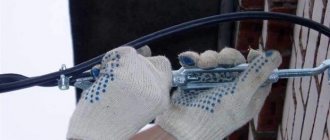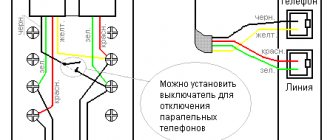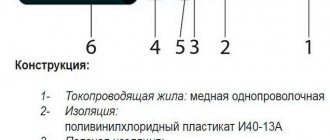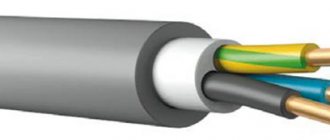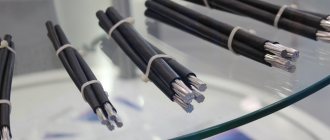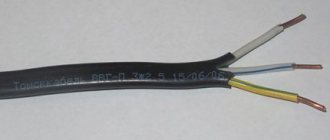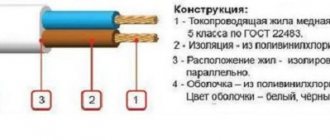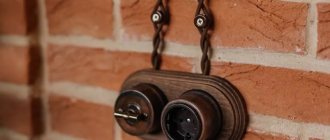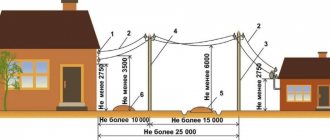Let's consider several options for solving this issue: it is convenient to arrange them in one list according to the complexity of the solution, communication range, signal transmission medium and cost of the issue.
A total of three options will be offered:
- Network via twisted pair cable (UTP);
- The network was built using Wi-Fi equipment;
- Network using fiber optic cable;
First, you need to measure the exact distance between the houses in order to decide which option will immediately disappear, and then we will plan what to pull where and how to connect.
So, let's look at each option in more detail.
Negative factors for street wiring
Cable lines laid outdoors are subject to several negative factors:
- Ultra-violet rays. Sunlight has a detrimental effect on some types of conductor insulation. This process is long and difficult to control. Therefore, you should choose products with insulation made from materials that do not deteriorate when exposed to UV rays.
- Ambient temperature. Low temperatures can lead to cracking of the insulation. Therefore, when choosing cables and wires, you should find out their operating temperature range. The installation temperature should also be taken into account. Usually it is not lower than 20 degrees below zero.
- Wind. Strong winds can damage both the cable line sheath and the conductors inside. If the cable is laid outdoors, the climatic area of installation should be taken into account.
- Ice. If the external network is installed in areas where there is increased ice formation in winter, it is worth taking this factor into account. A conductor covered with an ice crust can become several times heavier and break under its own weight over long spans.
There are three ways to lay cables outdoors, and each of them has its own advantages and disadvantages:
- By air. The fastest installation method. Disadvantages of this method: it requires reliable fastening of the cables, the lines are exposed to the negative influences of weather conditions.
- Along the walls of buildings. For this method it is much easier to select the conductor material. Disadvantages: labor-intensive installation, disruption of the appearance of buildings, negative impact on the conductor of ambient temperature and sunlight.
- In the ground. This method allows you to solve many problems. Weather conditions and sunlight have no effect. The appearance of buildings and surrounding areas is not disturbed. The disadvantage is that electrical installation is labor-intensive, in some cases requiring the use of construction equipment to excavate a trench.
Installation and operation of SIP
There are several SIP systems:
- Self-supporting SIP wire system
- SIP with isolated carrier neutral
- SIP with bare carrier neutral
Each system has its own designations and purpose.
SIP-4 consists of 4 aluminum wires insulated among themselves. Aluminum conductors have a cross-section of 16, 25, 35, 50 and 95 mm2. A distinctive feature is the absence of a load-bearing core.
SIP-3 has one wire with aluminum conductors made of light-stabilized cross-linked PE.
SIP-2 has four ethylene-coated cores, one of which is load-bearing.
SIP-1 represents the same 4 cores, three of which are coated with plastic, one bare neutral is self-supporting.
The PE sheath of the cable has high resistance to external influences, such as UV radiation or ice freezing. It protects the current-carrying part from oxidation and corrosion. The period of complete preservation of the properties of the PE shell exceeds 20 years with proper use. This once again requires a reminder that responsible electrical work, and connecting a sip pipe from a pole is a responsible job, must be performed by professionals.
The sheath should be elastic, this makes it easier to install the wire. Elasticity provides greater resistance to damage. The amount of steel in an aluminum wire depends on the place of its application: if SIP is laid along the facades of a building, the steel content in it should be low - this increases conductivity. If you plan to introduce wiring through a busy highway, you should use SIP, which contains more steel.
Cable laying over the air
While laying cables indoors usually does not cause problems for installers, laying cables between buildings over the air is usually more labor-intensive.
Communications between houses can be laid in two main ways: underground and by air. Each of these methods has its pros and cons. This article describes a method for laying cable over the air. The advantages of this method include the ease of installation (compared to the installation of underground communications); it is not always possible to lay underground communications; the length of the cable connecting houses is much longer than in the case of an air connection. Disadvantages of laying by air include exposure of air communications to static electricity and lightning discharges, severe weather conditions, which can lead to premature failure of the cable, in case of damage to the outer insulation of the cable due to friction of the cable in contact with other objects, or the occurrence of cracks Due to weather conditions, the cable picks up moisture and causes equipment failure (in this case, only replacing the cable can help). Let's consider connecting two houses by air. Hereinafter, we will agree to call such a connection an air connection.
In the figure: 1 – houses being connected, 2 – cable, 3 – information cable (twisted pair). This is a fairly rough outline of what should happen as a result. So, if you use twisted pair without a cable inside, then the use of a cable is simply necessary (wind, stuck wet snow, ice create enormous loads, the twisted pair cable is not designed for them). It is best to use insulated steel wire as a cable. The cross-section of such a cable with a reasonable air length (less than 80 m) is sufficient to be 1 - 1.5 mm2. Insulation is necessary to prevent corrosion, which can literally “gnaw through” a steel cable of such a small cross-section in just a year. It is necessary to attach the cable to the house to something durable (iron fittings, masts of other cables, etc.). Here the next nuance appears. It is necessary to prevent the steel cable from touching the metal fittings on both houses at the same time. Houses have different potentials, and therefore current will flow through the cable, producing interference on the twisted pair cable, and some other unpleasant consequences are possible. The cable must be grounded. Of course the cable needs to be grounded. It is possible on the one hand. But this will not be the best option, a much better option would be to ground the cable on both sides, but you must either ground it on one side through a container (hard on the other), or break the supporting cable in the middle using a dielectric (for example, from a PCB plate).
Now about the twisted pair cable. In our latitudes, a cable located in the open air finds itself in very difficult conditions. The cable stretched between houses is in particularly difficult conditions. Therefore, I recommend using twisted pair cable with special insulation for the external laying for the air. Ideally, such a cable will be filled with a compound (hydrophobic). The use of shielded cables, in my opinion, is inappropriate. A screen will not prevent the accumulation of static electricity in a cable, but cables with a screen are much more expensive. In order to save equipment connected to the air from discharges of static electricity and thunderstorms, it is necessary to use special devices, so-called lightning protection.
So let's get back to the air lining. The twisted pair cable must be attached to the cable in advance. Any non-conducting material that is not exposed to water and weather conditions can be used as fastening elements. It is most advisable to use nylon ties. Using nylon ties (or other devices), the twisted pair cable is attached to the cable, and it is recommended to fasten the cable and cable with ties every 50-70 cm. It is necessary to control that the cable sag slightly, otherwise it will turn out that the cable is also held by the cable. But at the same time, it is necessary to reduce the sagging to a minimum (in Fig. 1 there is a very large sagging, made solely for the clarity of the figure). It is necessary to tighten the ties firmly, excluding any sliding of the cable relative to the cable, but it is necessary to avoid damaging the cable by very tightly tightening the fastening element (it is necessary that the contact surface of the fastening element is flat and the width of the element is at least 5-7 mm).
Local network between buildings via wi-fi
(distance approximately 500 m, using external antennas – 1 – 2 km)
The first condition for using this method is direct visibility between the transmitting and receiving devices and the absence of any structures on the transmitter-receiver line. This option is very suitable when the houses are located one against the other and the windows of one house “look” into the windows of another house. It is desirable that it be floor 5 or higher, which will prevent the appearance of objects blocking the radio link.
So, if the distance between the windows of the houses is up to 400-500m and they are approximately at the same level (plus or minus 3 floors) - you will only need two access points, preferably with removable antennas. For example, let's take the TP-LINK TL-WA701ND equipment
Connect according to the manufacturer's instructions
We configure one of the access points in AccessPoint mode, and the other in Client mode.
see also
Comments 45
I buried 16m in metal plastic. for 2 bayonets, next to the path, so that no one would dig. 5 years so far no problems.
I have 3 meters from the bathhouse to the toilet. The electrical panel in the bathhouse. Consider running a cable along the bathhouse and hanging it from the bathhouse to the toilet on a metal cable. VVG wire 3 by 2.5 in a polypropylene corrugation. It’s been hanging like this for 3 years, everything is fine. Withstood the snow winter and rainy summer.
Along the fence, in the corrugation. And don’t say that there is no fence made of prof. Liszt.
The cross-section is at least 2.5 mm. The cable (wire) is better, of course, non-flammable. Provide a distribution box for the input machine and 2 outgoing lines (heating element and sockets). If external installation is possible, then use polypropylene as an option. I liked working with them. There are plenty of fittings, the prices are cheap. The track is sealed and there is always the possibility of crashing into it. Transitions, if required, are carried out on a cable in a metal corrugation. I refused to lay it in the ground. Digging deep (in terms of freezing level) is simply too lazy. And the water may be too close, and since it’s summer with constant rains, the cable will lie in the swamp.
In HDPE corrugated with a double wall at a depth of 50cm. Cable 3x2.5 num or vvgng. If there is no land, then to connect the boiler and pan you will have to weld a triangle or buy a ready-made solution. I do this for myself. Double-wall corrugated HDPE, 3x4 VVGNG cable (available), entry through the floor through a rigid pipe, switchboard with automatic switches, 3x2.5 sockets, 3x2.5 boiler and 1.5 light. THOSE. 4 modules input 25A, sockets, boiler 16A light 10A. Boxing, sockets, switches, IP 65 lamps in the workshop and shower, a simple lamp in the toilet. The walls are laid in HDPE rigid pipes.
One machine gun is enough for him) he’ll take him to the toilet, put the box there and throw it in front of the light, sockets, and switch) why bother so much...
I’m so bothered by the fact that my utility room is combined with a toilet and shower. In the utility room you drill, then saw, or do whatever else)
One machine gun is enough for him) he’ll take him to the toilet, put the box there and throw it in front of the light, sockets, and switch) why bother so much...
It is better to turn off the shower heater when bathing. And this means a separate machine.
He wrote in the topic through the outlet...
This is through the outlet for now. The tank itself is heated. The season was poking, and then I got tired of it. Moreover, the contacts begin to heat up, after all, it is better to make 2.5 kW in a reliable way, and not through a lousy plug-socket. I doubt that he will install expensive and high-quality ones, much less hermetic ones. I would like to connect my tank over time via a time relay. That I didn’t think about it at all and didn’t forget to turn it on.
This is all nonsense) you dig a trench about knee deep, there is a cable there and that’s it) A 3x2.5 cable is better, in a HDPE pipe.
What does better mean? Either in a pipe or armored.
People here write to pull the sip) for light and a couple of sockets and a heating element for the toilet) a 3x2.5 cable can withstand up to 5 kW) a simple black plastic HDPE pipe and that’s all)
You don’t understand, if there is no pipe then the cable must be armored. And it doesn’t matter, at least let the PVS pull
What are these strange holes in the walls?
In the walls of nine-story buildings there is often a secret hole with a pipe and a red letter “Ш” on top. It turns out that it is of particular importance because it helps utility workers check the level of gas pollution in basements.
This can be done thanks to a special device that is inserted into the same hole.
See also:
Chocolate truth - 5 surprising facts that will improve the mood of those with a sweet tooth
By air or underground: how to supply electricity to a country house?
Every summer resident, when landscaping a country house, is faced with the question of supplying electricity: by air or underground? Which is more durable, cost-effective and aesthetically pleasing? All the pros and cons of each method in our article.
In most cases, in holiday villages, electrification from the transformer substation to the pole near the house is carried out by air. And here the owner of the house does not choose - how the electricians make the line will not be the same. But entry into the house and wiring around the site is the choice exclusively of the owner of the country house. In this article we will talk about the pros and cons of each installation method.
How to increase the range of a wifi network connection between two houses?
It may seem funny, but so-called “can reflectors” can increase communication range and stability
The access point's circular antenna turns into a highly directional one.
The reflector presented below, placed on only one of the router’s three antennas, amplified the signal received by the phone from -62 dBm to -51 dBm.
For the test, we used a Xiaomi Redmi 4 Prime phone with the WiFiAnalyzer application installed. Signal reception from a distance of 30 - 35 m (through a window onto the street).
Using factory-made external antennas with increased gain, the coverage area increases significantly and can reach several kilometers.
Advantages of the method:
Easy to install. In fact, you need to take it out of the box, connect it and make a few clicks. Mobility of installation - when moving, everything can be easily packed into a suitcase and used in another place.
Disadvantages of this method:
Sensitivity to interference, especially when installing more powerful antennas. The equipment is more expensive than copper cable. Suitable only in case of direct visibility between access points. Bandwidth depends on signal strength.
Laying wire through the air
This is the most popular and seemingly simple way to bring electricity into the house. There are advantages and disadvantages of this method of organizing input.
Advantages of an overhead line:
- Installation speed . Tensioning the bushing from the support to the insulators on the house takes no more than 40 minutes. In this case, the overhead line, which powers other houses on the street, will be turned off for no more than 10 minutes (it is necessary to connect the phase and neutral wires to the line), so the neighbors will not have time to express dissatisfaction due to the lack of light.
- Easy to maintain . The wire itself does not require maintenance unless it breaks due to a fallen tree or ice. If this happens, its repair will take relatively little time. Please note that it may be necessary to clean and tighten the contacts on the wire from time to time if the connection is made with regular twisting and not with piercing insulators (nuts).
- Relatively cheap . On average, 1 m of 4x16 SIP wire costs 60 - 70 rubles. For input, assuming a distance from the support to the wall of the house of 10 m, you will need about 13 m of wire (additional 3 m for installation in the panel and reserve in case of repair), which will be approximately 900 - 1000 rubles plus 1000 rubles for the installer to hook up the wire for a support, about 2000 rubles . This is several times cheaper than laying a cable, which costs on average 120 rubles per 1 m (AVBbShv cable).
Disadvantages of an overhead line:
- Exposure to environmental factors . Unlike a cable in the ground, an “overhead” wire is exposed to ultraviolet radiation, which affects the condition of the insulation, wind loads, lightning, icing and falling trees, which simply tear the wires. If it breaks from a support or at a connection near the house, then it’s no big deal, as it can be quickly repaired without twists. And if the wire breaks in the middle of the span, then in order to avoid voltage losses due to twists, the entire wire will have to be replaced, and this is an additional considerable expense.
- Obtaining permission to install a support . This may be required if the distance from the support closest to you to the entrance to the house is more than 25 m. Then, in order to avoid sagging of the wire, you will need to install an additional support, the installation of which on average costs 15,000 - 20,000 rubles, depending on the region of residence and the distance of the installation organization from yours country house. Connecting the overhead line to the house is carried out according to the following scheme:
- Lack of aesthetics. For many owners of country houses, the aesthetics of the electrical network is a key factor. Hanging wires spoil the appearance, while a buried cable is nowhere to be seen.
- They can be a nuisance in the yard. Many owners additionally route wires through the air, connecting a shed, workshop or garage. If you have large-sized agricultural machinery, then there is a possibility of breaking the wires by snagging them. In this case, you will have to route the wires in armored sleeves along the fence or walls, or lay the cable underground.
Advantages of using SIP when connecting a house from a support
Today, entry into a private house is carried out exclusively with SIP wire. Cost savings and high advantages of SIP over conventional bare wires make its use the most popular.
- The special design and thoughtful suspension scheme makes both installation and fittings much more economical than using non-insulated lines;
- even if the wires overlap, the occurrence of a short circuit will tend to a minimum;
- The reinforcement has high tensile strength. This allows you to maintain the integrity of the wire when external loads occur - contact with fallen tree branches, unsuccessful vehicle passage, or insufficiently careful operation of the PMG;
- there is the possibility of installation using the walls of buildings;
- working under voltage with self-supporting insulated wires reduces injuries.
Designation on the SIP wire:
- C - means self-supporting wire
- And - talks about insulation around current-carrying conductors
- P - indicates that this is a wire
SIP wire has five main versions. Differences in the load-bearing core and in the number of insulated cores.
Unaccounted for connections, which were previously made using a simple throw-on method, are significantly reduced. The operating costs of the system are significantly reduced, since hanging the wire on supports is a very simple and reliable system.
Laying cables in the ground
Laying cables, like overhead power lines, has its pros and cons.
Pros of a cable line:
- Aesthetics . Laying cables allows you to avoid unnecessary wires and at the same time beautifully landscape the territory of your home.
Reliability and durability. If all technological processes are followed, including correct connection of the cable to the overhead line on the pole, installation in a PVC pipe and protection of the cable from moisture, the cable can serve its owner without repair or revision for up to 30 - 40 years. It is also not afraid of external environmental factors, since it is buried in the ground.
- Cost-effective when the support distance is large from the house . Although on average the cost of a cable is more expensive than an overhead wire, however, if the overhead line is far from the house, you will not have to obtain permission to install an additional support and pay money for it. Digging a trench and laying cables in this case will cost much less, and you can do it yourself, without resorting to the services of installers (except for connecting the panel to the support).
Disadvantages of a cable line:
- Danger of theft . Unfortunately, in Russia, hunters for non-ferrous metals have not yet been canceled. The cable coming down from the support is visible to the naked eye, so the section from the support to the fence can be dug up and stolen. Of course, this does not happen all the time, but there have been cases.
- Obtaining permission to dig if there are underground communications nearby. If a gas or water pipe is buried near your house, then you will need to invite a representative of Gorgaz or Vodokanal to coordinate the digging of a trench. This takes additional time and you will have to pay for the visit of a representative of the relevant service.
- Laying time. Digging a trench, laying a pipe and pulling a cable along it takes many times longer than stretching the input with a self-supporting insulated wire.
- Total cost of installed cable. If the overhead line does not require additional support, then laying the cable line will cost more. If it is necessary to lay the same 13 m of AVBbShv 4x16 cable (for clarity, we take it as for an overhead line) in a plastic corrugated pipe with a diameter of 110 mm (costs on average 100 rubles per 1 m), provided that you dig a trench yourself, then the cost of installation will be: (13 *120) + (13*100) = 2860 rub.
It is worth considering that you will need to pay the installer about another 1000 rubles for connecting the cable in the panel (or on the support). The total cost will be about 4,000 rubles , which is more expensive than pulling an overhead line.
Difficulty of repair. If a breakdown occurs in the cable somewhere in the middle (not at the inputs), then you will have to dig out the entire buried structure, which takes a lot of time and creates a lot of problems (especially in winter). Also, no objects can be built in the cable laying areas - again for reasons of future repairs.- The need to draw up a drawing . Since the cable line is not visible to the eye, it is necessary to draw up a detailed drawing so that in 20 - 30 years, when your children or grandchildren live in the house (or you sell it), no one accidentally stumbles upon the cable when they dig a trench under the foundation extension or garage. Also, a drawing is needed for repairs so that you know where to dig.
Rules and regulations
The main condition for the trouble-free existence of buildings on a land plot is compliance with all the necessary rules and regulations provided for by existing legislation. SNiP 30-02-97 as amended for 2022 and SP 53.13330.2011 are now being considered at the legislative level.
Power lines near the city
A safe distance from power lines can be determined even independently, although when obtaining permits, officials approving the construction project must indicate the inadmissibility of being close to power lines. According to existing rules, the minimum safe distance from the supporting electrical wire of a structure is determined as follows:
- 35 kV, on a pole - 3-4 insulators - 10 meters;
- 110 kV – 6–8 insulators – at least 20 meters;
- 220 kV – 15 insulators – from 20 to 25 meters;
- 330 kV – 2 wires in a bundle on one phase of a power line column – required distance – 20–25 m;
- 500 kV – 3 wires on one phase – distance requirements – 30 meters;
- 750 kV – 4 wires in phase – 40 meters;
- 1150 kV – 55 m minimum recommended distance, although you can find recommendations to add another 5–10 m.
Power line
Calculating the distance from the fence to the power line support is fundamentally incorrect. According to the rules, such a distance is defined as a perpendicular drawn to the fence post from the extreme line of wires. The minimum height for a power transmission line is considered to be 7 m, which means that under unfavorable conditions, the charge accumulated by it can be discharged into the atmosphere, causing destruction and irreversible consequences. Therefore, for greater safety, it is not the distance from the support that is considered. The required meters must be measured from the outermost point of the wire located on the side of the fence.
Conclusions: should you choose an overhead or cable line?
An air line is suitable for you if:
An underground cable line is suitable for you if:
- The appearance of your site is important to you.
- In your area, there are strong winds and wires often break due to falling trees.
- You have large-sized agricultural equipment, and you need to power several buildings in your yard.
- The power line support is located more than 25 m from your home, and you do not want to spend money on installing an additional support.
Why are there wires between them?
Walking next to nine-story buildings, you can notice a huge number of wires. Residents of large cities often get the impression that there is a real web stretched over their heads. But few people know why these wires are needed at all.
It turns out that they belong to three large categories of electrical communications:
- Wired radio network. Currently, technology is changing, and such wires are becoming less and less common. However, they managed to pull so many of them that they will hang over our heads for a long time.
- Segments of cable television networks and Internet providers. Typically, such communications are pulled along the roofs of houses, since laying them underground is much more expensive and difficult.
- "Special wiring." This includes cables for elevator dispatch communications, various individual networks or emergency communications.
Having considered all the options, it becomes clear why hundreds of wires stretch between high-rise buildings. But the problem is that they are very susceptible to external factors and can rupture under the pressure of strong winds.
See also:
5 surprising facts about Soviet trains that we didn’t know
Cheapness of land plots in the sanitary zone
Based on SanPiN norms, construction rules were determined and security zones were created under high-voltage lines. Any children's institutions, including educational ones, located at a dangerous distance, must be closed. It was prohibited to build residential buildings for permanent and temporary residence closer than the minimum distance to high-voltage lines specified in SanPiN 2971-84.
At the power plant
Please note that it is not possible to sell a house located in a dangerous zone. No sanitary or fire safety organizations will approve such a document. When developing land plots of individual housing construction, it is necessary to take into account the distance to the power line located nearby.
Land prices show how dangerous the radiation from high-voltage lines is for human health. You can notice that the cost of land near power lines is low. As you move away from it, it rises every 30 meters. You shouldn't be foolishly tempted by a cheap price. First of all, you need to think about the health of your family.
